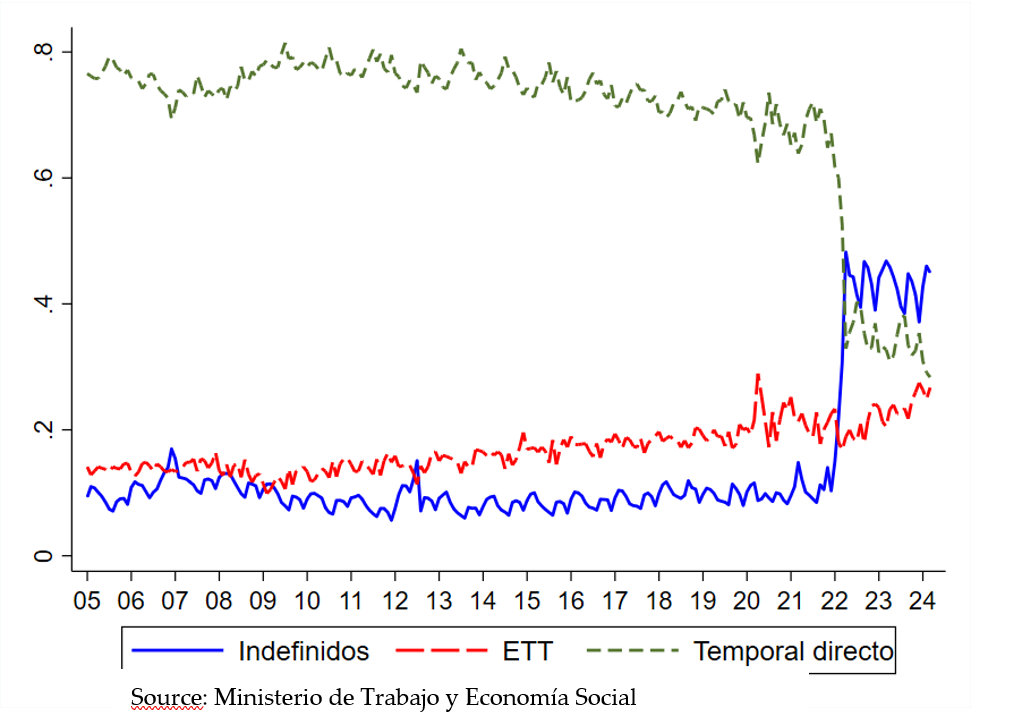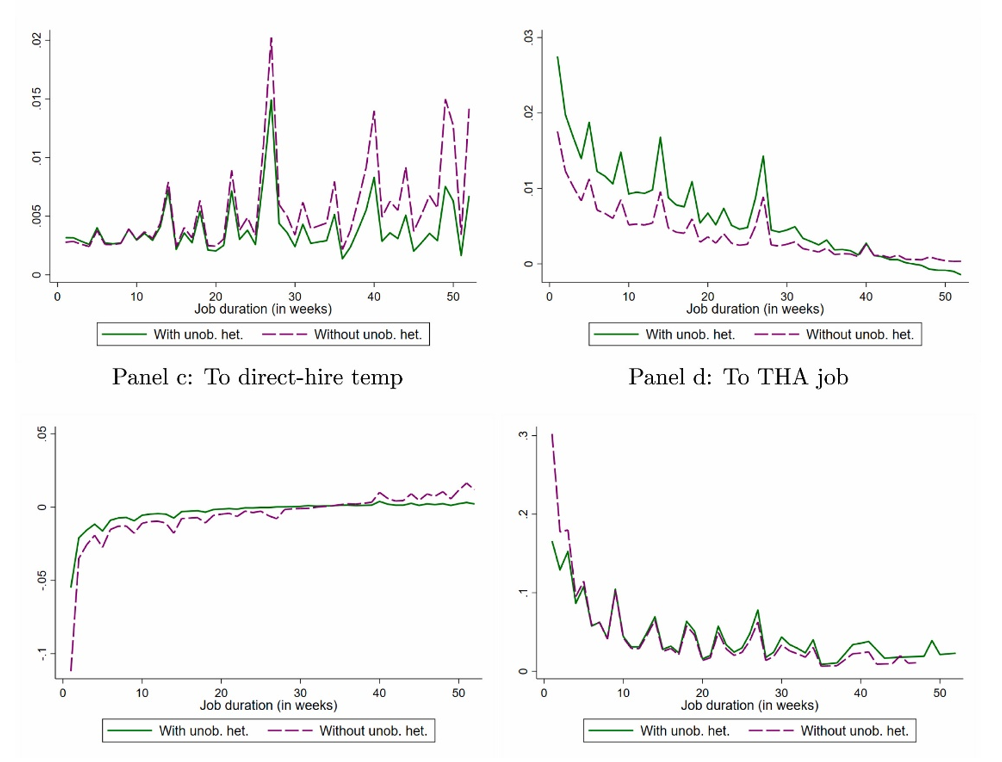Are they a trampoline or a trap for low-skilled workers?
Based on research by Raquel Carrasco, Ismael Gálvez-Iniesta, and Belén Jerez
Temporary help agencies (THAs) have experienced significant growth in most developed countries since the 1990s. In Spain, although they only represented about 4% of total employment in 2023, they accounted for nearly 25% of all new contracts signed. Moreover, THAs have proven resilient in the face of labor reforms. As depicted in Figure 1, while direct temporary contracts (those not involving agency intermediation) have decreased from 70% to 40% of all new contracts after the 2022 reform, the proportion of contracts facilitated by temporary work agencies has remained roughly stable.
Figure 1: Contracts signed by month by type of contract (% of total)

It is frequently argued that this type of employment provides firms with greater flexibility to adjust to fluctuations in demand and to reduce non-wage costs such as worker search and screening expenses. However, its increasing prevalence, along with other non-standard employment types like subcontracting or job outsourcing, has sparked intense debate regarding its impact on workers’ lives. Indeed, temporary agency work is widely associated with precariousness and job instability.
In a recent paper, we investigate the impact of holding a temporary contract through a temporary agency as opposed to a direct temporary contract on the likelihood of transitioning out of temporary employment into various other employment statuses, such as permanent employment, temporary employment, or unemployment. Our study focuses on men aged 20-45 with secondary education or lower, representing the primary demographic group utilizing THAs in Spain. We use data from the Muestra Continua de Vidas Laborales (MCVL) spanning from 2005 to 2017, which provides detailed work history information for a representative sample comprising 4% of workers affiliated with Social Security.
Our empirical approach is based on estimating discrete-time duration models that allow for unobserved worker heterogeneity. We analyze the impact of having a temporary contract through an agency on weekly job transitions and examine how this impact varies with the duration of the contract. Considering the contract duration is crucial in this context, particularly given the well-documented short durations of temporary contracts in Spain (in our sample, agency and direct temporary contracts average 4 and 10 weeks respectively).
Figure 2: Marginal effect of THA contract models with and without unobserved heterogeneity

Our results can be summarised as follows:
- Working through a temporary agency instead of holding a direct temporary job increases the likelihood of transitioning to unemployment. Despite the negative duration dependence, this effect persists across all durations. Our estimates also indicate that the impact of temporary agency work on the probability of entering unemployment is amplified when we account for unobserved heterogeneity compared to when we do not. This suggests that a significant portion of the higher unemployment risk for agency workers stems from the characteristics of their jobs (such as low quality, short duration, or low productivity) rather than from unobservable worker characteristics.
- Agency workers are also more likely than direct temporary workers to move into permanent jobs at all durations, although this is rare in our sample.
- Agency workers tend to sign new agency contracts more frequently, a phenomenon rarely observed among direct temporary workers. The estimated risk for agency workers is 16.8% in the first week of employment, decreasing to 8.8% after one month, indicating a high persistence of agency employment. In contrast, the probability of direct hires becoming agency workers is close to zero, regardless of the contract duration. Our estimates show that worker self-selection plays an important role in this transition: the effect of working through a temporary agency on the probability of signing a new contract with a temporary agency is reduced when we account for unobservable worker heterogeneity.
We hypothesize that agency workers are more likely than direct hires to engage in repeated agency work if their unobserved characteristics make them more averse to unemployment. Factors such as lower socio-economic status, weaker connections to the labor market, or childcare responsibilities could contribute to this aversion. Consequently, these workers are more inclined to sign new temporary contracts through a temporary agency to avoid unemployment or exit it quickly.
Our results align with the monopsonist behavior of THAs in the low-skilled labor market. This behavior may stem from several factors. Firstly, workers who self-select into temporary employment might have a higher aversion to unemployment, leading to a lower labor supply elasticity. Secondly, temporary employment agencies specialize in recruitment and can benefit from economies of scale, giving them market power. Compared to firms that hire temporary workers directly, temporary work agencies may extract more surplus from their labor pools, where workers compete directly with each other. Although equal pay laws aim to curb this monopsony power, our analysis suggests that the influence of temporary work agencies extends beyond wages, affecting contract stability and job security.
Compared to their direct-hire counterparts, low-skilled agency workers are often caught in a cycle of short and unstable contracts with a higher risk of unemployment. This pattern suggests a concerning scenario where agency jobs, rather than serving as a stepping stone, could act as a ‘trap’, particularly for workers in lower occupational categories, hindering their progression to stable employment.
However, in our sample, these jobs tend to offer higher starting wages than direct temporary jobs, consistent with the idea that agency workers are compensated for their shorter contracts. A comprehensive empirical analysis focusing on wages is beyond the scope of our paper, as is an examination of the potential long-term effects (i.e., scarring) associated with agency work in terms of job instability and lifecycle wages. Additionally, our estimates do not consider the impact on women and workers with tertiary education. We will address these aspects in future research.
Finally, since our analysis uses data from social security records, it is important to note that we do not have information on the client firms that employ agency workers. Specifically, we lack details about the tasks performed by these agency workers and their sector of activity, as they are employed by the agency rather than directly by the client. We urge the administration to make a greater effort to make this information more widely available, as it is crucial for advancing research in this area.
Further Reading:
Carrasco, R., Gálvez-Iniesta, I., & Jerez, B. (2024). Do temporary help agencies help? Employment transitions for low-skilled workers. Labour Economics, 90, 102586. https://doi.org/10.1016/j.labeco.2024.102586
About the authors:
- Raquel Carrasco is Associate Professor at the Economics Department of Carlos III University. She works on Labour Economics and Microeconometrics. Website
- Ismael Gálvez-Iniesta is Assistant Professor at the Department of Applied Economics at the Universitat de les Illes Balears (UIB). He works on labour markets and migration. Website
- Belén Jerez is Full Professor at the Economics Department of Carlos III University. She works on General Equilibrium, Search Theory, and Macroeconomic Applications and Information Economics. Website



